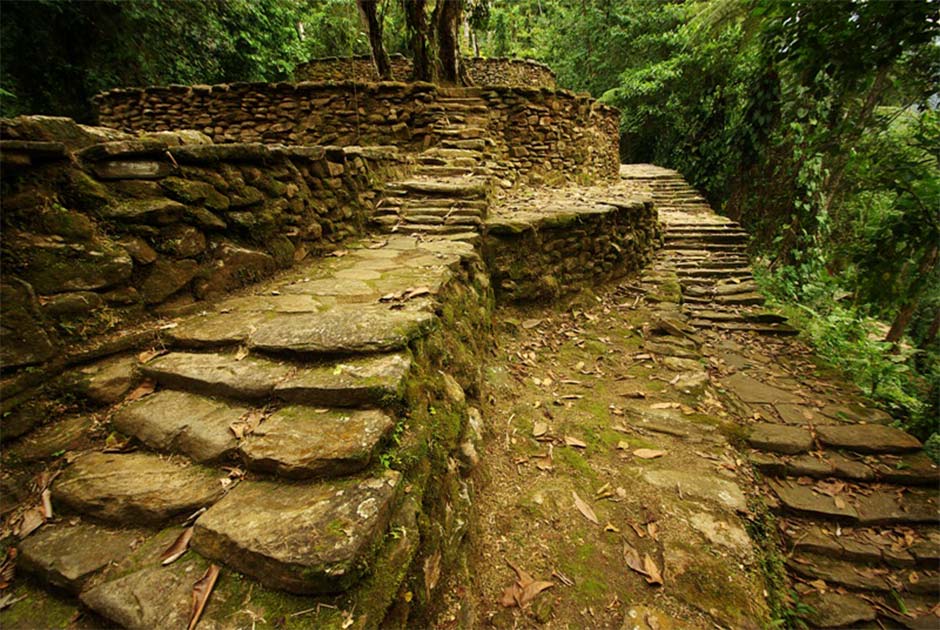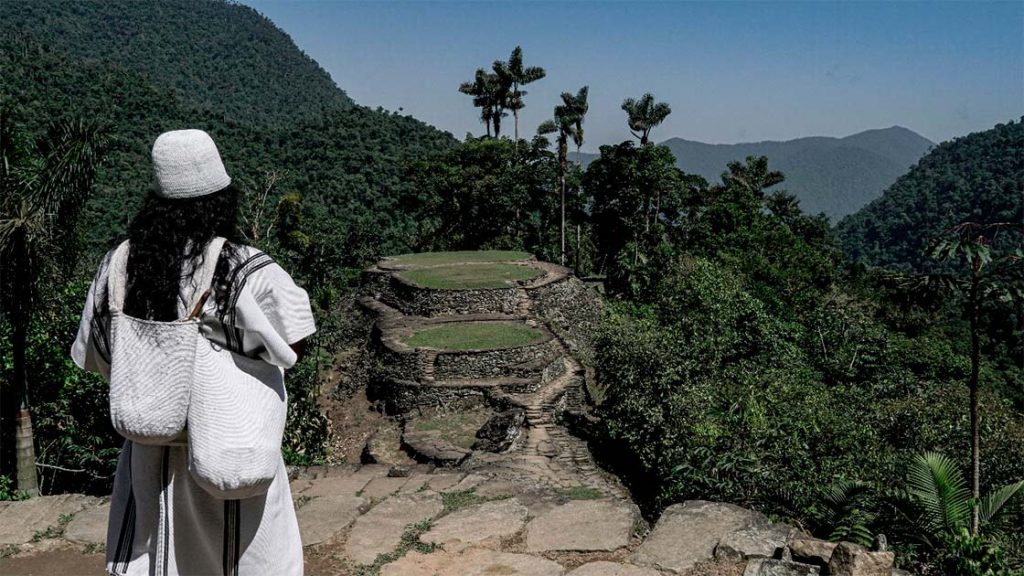Hidden deep within the lush jungles of Colombia lies a mysterious archaeological wonder known simply as Ciudad Perdida, or “The Lost City.” This ancient city, shrouded in history and veiled by centuries of dense vegetation, has piqued the curiosity of adventurers and archaeologists alike since its rediscovery several decades ago.
Once the home of a peaceful indigenous people, Ciudad Perdida hides a dark history: brutal European colonization, greed, and slavery led to the splendid city’s abandonment. Today it is a ruin of what it once was, but efforts are being made to protect it.
Gold, Slavery and Colonization
Nestled within the jungle mountains of the Sierra Nevada de Santa Marta, Ciudad Perdida, also known as the “Lost City,” is a captivating archaeological site that remains a testament to the ancient indigenous cultures that once flourished in the region. Stretching over 1,000 years into the past, this city’s history is a complex tapestry of ancient societies, mysterious origins, and a legacy that continues to intrigue modern historians.
It’s believed that the city was built around 800 AD and was once the region’s political and manufacturing center on the Buritaca River. Estimates vary but experts have estimated that the city was home to anywhere between 2,000 and 8,000 people during its heyday.
Ciudad Perdida was rediscovered in 1972 by a small family of treasure looters known as the Los Sepúlvedas. It would seem that the Los Sepúlvedas made one of the greatest archaeological discoveries in modern times while out turkey hunting.

The discovery was pure chance. The family shot a wild turkey and while retrieving it discovered that it had fallen on some stone steps that rose up the mountainside. The Los Sepúlvedas followed their treasure looter instincts and climbed up the steps until they came across the abandoned city of Ciudad Perdida, or as they called it “Green Hell.”
And Hell it was. Greed soon got the better of them and one of the Sepúlveda sons was shot at the site not long after this discovery, leading to fighting among the looters. In the following days and weeks, gold figurines and ceramic urns from the city began to appear on Colombia’s black market.
- Machu Picchu Facts – 11 Fascinating Details of the Inca Citadel
- Who Built the Abandoned City of Djado? A Saharan Mystery
This set off alarm bells among the region’s archaeologists and a team led by the director of the Instituto Colombiano de Antropología arrived at the site in 1976. Looters had done their fair share of damage by then leading to the site being restored between 1976 and 1982.
The Lost Builders
The Lost City of Ciudad Perdida was a remarkable creation of the Tairona people, an indigenous group who inhabited the Sierra Nevada de Santa Marta region in Colombia. These skilled and resourceful builders constructed the city around 800 AD, making it a demonstration of their advanced civilization and architectural prowess.
The Tairona were a society deeply connected to the land, and this connection is evident in the construction of Ciudad Perdida. They developed a sophisticated system of agriculture, utilizing terraces to cultivate crops like maize, beans, and yuca in the steep mountain terrain. Their intricate knowledge of soil management and irrigation allowed them to thrive in this challenging environment.
The city itself was built with meticulous precision. Circular stone plazas, pathways, and terraced structures were meticulously crafted, showcasing the Tairona’s architectural finesse. These stone structures not only served as dwellings but also played significant roles in the spiritual and social life of the community.
The Tairona’s beliefs and customs were deeply intertwined with the landscape, and they revered the natural elements, such as the sun and the surrounding mountains. Ciudad Perdida’s layout and architecture reflect their spiritual connection to the world around them, with the city’s structures aligned with astronomical events and sacred geometry.
So why did the Tairona abandon a land they loved and worshiped? Unfortunately, it all comes down to European explorers colonizing the region, enslaving its inhabitants, and spreading diseases that the locals had no defense against.
The first Spanish explorers landed in the region in 1514 led by Rodrigo de Bastidas and later Gonzalo Jiménez de Quesada. They brought with them diseases such as smallpox and measles.

These diseases, to which the indigenous populations had no immunity, decimated their communities, including those inhabiting Ciudad Perdida. The devastating impact of these diseases led to a significant decline in the Tairona population.
The brutality of Spanish colonization also played a crucial role. When the Europeans first arrived and began settling indigenous lands one of the first things, they did was to enslave the Tairona who fished and collected salt along the coast. Those who escaped fled to Ciudad Perdida, which was reliant on the fish and salt they collected.
The Tairona of Ciudad Perdida were a peaceful people and at first tried to appease the Spanish. They sent the escaped slaves back with gifts of gold in the hopes it would keep the foreign invaders at bay. Unfortunately, it did the opposite. Sparked by greed the Spanish conquistadors started heading inland towards Ciudad Perdida.
The Tairona didn’t go down without a fight and for nearly 100 years they resisted the Conquistador’s attacks. Unfortunately, they lost their territory bit by bit and the Tairona people faced violence, forced labor, and exploitation under Spanish rule. Many were enslaved, and their cultural and religious practices were suppressed, leading to a gradual erosion of their way of life and their ties to Ciudad Perdida.
At some point in the late 1500s, the remaining Tairona inhabitants abandoned the city, retreating deeper into the mountains to escape the Spanish conquest. Over time, the once-thriving Ciudad Perdida was reclaimed by the dense jungle, hidden from the world for centuries.
A Lost City
Today, Ciudad Perdida stands as a poignant reminder of the complex and often tragic interactions between indigenous cultures and European colonizers during the age of exploration. The effects of colonization can still be felt. After the Tairona fled the Spanish took more and more of the gold that had once belonged to this proud people until nothing was left.

Where is that gold today? Much of it sits in museums across Europe where the Tairona’s modern-day descendants, and indeed to surviving Tairona themselves, will never see or benefit from it. Not that gold is particularly important to them. What they care about is their ancestral land, which they still believe to be sacred.
Thankfully, things are looking up. In 2009 the Global Heritage Fund, a non-profit organization began working in Ciudad Perdida. With the help of locals, it is working to protect the site from climate, vegetation, neglect, looting, and unsustainable tourism.
Compared to those that have come before, the organization is dedicated to working with indigenous communities, not against them, to ensure that Ciudad Perdida will be preserved with respect for many more years to come.
Top Image: The ruins of Ciudad Perdida. Source: Camilo / Adobe Stock.